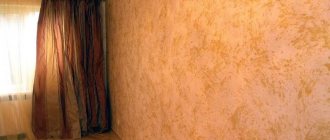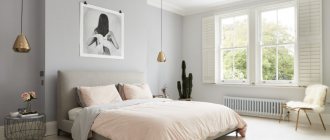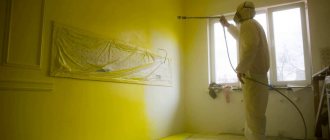Primer...good idea!
Proper preparation is the basis. Even the best coatings and the most expensive paints will not pass the test if the wall surface is not cleaned of stains, mildew and mold. Before painting, it is necessary to remove contaminants and remove irregularities that could cause cracking of the new layer. They can disrupt the smooth structure or contribute to the formation of streaks and gaps. It is also important to fill cavities, cracks and holes in the walls by polishing them and removing dust.
Preparation will also require the use of a primer paint or primer, such as latex primer emulsion. The role of the product is to level out the absorbency, homogenize the substrate, as well as improve adhesion and reduce paint consumption. The effect of this will not so much reduce repair costs as it will reduce operating time. In this case, the expected result can be achieved after applying the first layer of the new color.
How to apply primer? It is better to start from corners and hard-to-reach places. To do this, use a small brush or a paint roller with a width of 10 to 15 cm. Then, moving at right angles, we move to larger surfaces with a roller up to 25 cm wide.
Preparing the wall surface
How to paint the walls in an apartment correctly? Before you start working directly, you should carefully prepare the walls. The accuracy and beauty of the paint application will depend on how carefully you treat the walls. The preparation process consists of several stages:
- Preparing the room
- Surface cleaning
- Removing cracks and irregularities
- Primer
Working with paint is dirty; if you accidentally swing a brush or roller, the stains can spread throughout the room. Therefore, block off the entire space with film. Turn off the electricity, just in case you accidentally touch an outlet, you will be safe. The joints between the floor and walls can be sealed with masking tape. Do the same with the sockets.
The surface of the walls must be thoroughly washed. Remove any existing stains, mildew or mold. You can use vinegar or ammonia. Also get rid of the old coating, if any. If you bought paint that can be applied to other types of finishes, then make sure that the old layer adheres well, does not fall off anywhere, or peel off. Otherwise, you need to get rid of these shortcomings. Old paint from walls can be removed with a special compound that is sold at a hardware store. If you previously had wallpaper, remove it with a spatula and warm soapy water.
Primer is a necessary type of work and should not be skipped. It will protect your walls from the formation of fungus and mold. It will make the surface smoother, so your paint will not be absorbed into the base coating, and this will significantly save consumption. It is best to apply two layers. If your base coat is made of concrete, you can apply all three layers. Concrete is very absorbent, so let it absorb the primer rather than the paint. After priming, get rid of large cracks and holes.
Paint selection criteria
Choose thick paint, especially if you take on the task of painting a dark wall snow-white.
On store shelves there are products with different levels of coverage - from high to low, with lower or higher costs. Price in this case should not be a factor determining the choice, because often the cheaper paint is the least economical. It will require the application of several additional layers and, thus, will require more time and the repair will be delayed. This also doesn't mean you have to find the most expensive paint. The most important criterion is quality! To choose the right paint, it is best to analyze the information on the label. The label contains detailed information about its purpose, type of substrate, coating. It indicates the drying time and productivity, which determine the size of the surface that can be painted over with one liter of product. In addition to them, it is worth paying attention to whether the paint has expired. This can greatly limit its effectiveness. It is also worth familiarizing yourself with the manufacturer's recommendations, for example regarding paint thinning. If they are not there, do not experiment and do not look for savings, because the effect may be counterproductive.
Types of paints
Paint can be used both for decorative finishing and for surface protection. They differ in their composition:
- Emulsion
- Alkyd
- Adhesive
- Silicate
- Polyurethane
Emulsion paints are some of the best. They are distinguished by high characteristics: their consumption is minimized, they are harmless and odorless, and dry quickly. But they can only be used in heated rooms. There are several types:
Acrylic. They are pricey, but they are worth every penny spent. Acrylic paints are durable and not afraid of light. However, they are not used in rooms with high humidity; despite the fact that they repel water, they are still afraid of it.
Latex. The most expensive. Due to the latex content, the paint dries very quickly. It can be applied to wallpaper or bare walls. Masks minor surface imperfections. But this type is less resistant to light.
Water-based. Dries almost instantly. Very durable, mask small cracks and have a huge variety of choices. They are not afraid of water, but if washed too often, the coating may lose its appearance.
Water-dispersed. The main advantage is moisture resistance. Can be used for coating in damp areas. Most often they are produced in white, which means they will have to be diluted with color. They are afraid of cold rooms.
Silicone. Due to the silicone content, this type of paint is the most elastic. They can be applied to cracks, to any coating, even with old finishes. The downside is that it takes a long time to dry.
Alkyd paints come in two types: oil and enamel. The paint will emit an odor for some time after application. They cannot be washed and they support combustion. They are not often used inside living rooms due to their harmfulness.
Oil-based alkyd paints emit toxic substances during operation, but are very cheap. They take a very long time to dry. Enamel ones dry much faster and will not fade during use.
Adhesive paints are afraid of water. They are more suitable for ceilings than for walls, because they are not recommended to be washed frequently and can fade in the sun. But they are much cheaper than many other types.
Silicate paints will last for many years, but they contain alkali, which increases the risk of damage during operation. Not suitable for all types of surfaces and do not come into contact with other types of paints.
Polyurethane paints are rarely used due to their cost. But they are worth the money. They are not afraid of light, temperature changes and chemicals. They will last a very long time. They are most often used to paint a bathtub or kitchen, as this coating can withstand all conditions.
In addition to composition, paints are also distinguished by texture. There are relief ones - the surface will not be smooth, but with roughness. Decorative ones create an imitation of natural materials. Matte paints are difficult to clean, so they are used in living rooms or bedrooms. The glossy surface is suitable for finishing the bathroom and kitchen, as it is easy to clean.
Tools
White walls are not just a matter of proper preparation and a good coat of paint. Roller tools make a big difference too! The most versatile are those with medium bristles (suitable for painting mineral plasters and structural wallpaper). However, if you need to paint rougher surfaces of concrete, brick or structural plaster, it is better to use a roller with long bristles. This will allow you to cover the uneven surface tightly without gaps.
The material from which the roller is made is no less important. Here the choice should depend on the type of paint used. Waterborne paints are best applied using microfiber rollers. Oil paints are usually applied using wool, acrylic or velor, latex and dispersion, string, and sponges. You need a ditch to apply the paint evenly. A film that will protect furniture and floors from dirt and masking tape.
The main question: how to paint? The first step is to prepare the video. If it is new, it should be moistened and excess water squeezed out. It is also worth removing loose bristles using self-adhesive tape. They can leave unsightly marks.
Start by painting the ceiling (if the room has a window, work from the frame to the inside), then move on to the corners and walls. At the very end, the surface should be smoothed by moving the roller from top to bottom. This will avoid streaks and stains and thus ensure a perfectly painted wall.
Technology
A layer of primer is applied to the surface prepared for repainting , which creates an invisible film and is especially important in cases of strong changes in color. The primer mixture is applied in an even layer at a consumption of approximately 100 grams per m2 and smudges of the composition are immediately removed, since its base is glue and it will be difficult to remove it from the floor after setting.
The pigment is added to neutral-colored paint and mixed using a mixer, making sure that it is clean, otherwise the finished composition will have to be filtered. It is important to choose the right roller for repainting, since corrugated wallpaper requires a medium-pile tool, while a smooth surface can be treated with a foam roller or velor tool.
A telescopic rod for a roller will not be superfluous in the work, however, if you have not used it before, it will not speed up the process, but a bath for paint is necessary. First, use a brush to trim hard-to-reach areas, after which you can roll the entire wall, applying the first layer in any direction, and the second in the direction of the light. The interval between applying layers of acrylic paint should be at least 4 hours at a humidity of up to 60% and a temperature of 20 degrees. Remember that the paint dries darker , because when the water evaporates, the concentration of the dye increases, so do not make the color too dark, at least for the first layer.
You should always dilute acrylic paints with a reserve, since you may have to repaint the walls not in two, but in three layers (depending on the degree of color change) and remember the saying “the reserve does not last your pocket,” but you can find out about the approximate consumption of acrylic paint here.
If you are planning to repaint the walls in a different color yourself, then carefully prepare for the finishing and take your time in the process - this will guarantee a successful job, and we also suggest that you familiarize yourself with how to repaint the ceiling if your neighbors presented you with a “surprise”.
Questions and answers
Is it necessary to prime the walls?
A primer is considered mandatory if you dramatically change the contrast of the color of the walls, for example, blue to light green. In any case, priming will not hurt and will not take much time, so it is better to prime than not. A primer is also necessary if you want to remove greasy stains on wallpaper, but first you need to go over the stain with a detergent.
Does the direction of movement of the roller matter when repainting?
It doesn’t matter that they don’t say “docks” there. As a rule, the direction of movement of the roller is important when applying the second layer when painting the ceiling, since the light falls on it better - one and the plane is completely open - two. On the walls, when painting them with acrylic, there will be no streaks depending on the direction of movement of the roller, but the paint must be rolled out carefully.
Patience pays off
Painting—no matter the color you choose—is a lesson in patience. It is not recommended to rush, because it can ruin everything. You don't want to redo everything, do you? The key to effective performance is to follow the drying time indicated on the label. This applies not only to the first coat of paint, but also to primers. Factors that can speed up this process slightly are optimal conditions, that is, a temperature between 10 ° C and 25 °. C and well ventilated room.
After years of dominance by greys, browns and soft greens, white is making a comeback. Walls in such a universal color decorate the room, visually enhance the interior and fit into any style. Therefore, more and more people are ready to use white in their interior. As it turns out, repainting a darker surface a lighter shade isn't that tedious. Good tools, quality paint and a little patience are enough to achieve results.
Paintable wallpaper is the best option for those who want to make their interior unique. Their essence is quite simple: a clean canvas sets the relief, and paint sets the color. This solution is beneficial for those who are tired of seeing colorful drawings on the walls, wasting time on joining them, or simply want to use the canvas as a canvas for drawing. The article tells you which canvases can be painted and what you will need for this.
DIY wall painting
If you have white paint and color, then first you need to dilute them. Try diluting in a small container to the desired color. Remember the proportions and transfer them to the bucket.
How to paint walls yourself:
One surface should be painted at once. Under no circumstances leave a wall painted only halfway for a long time; this will lead to the border at the junction being visible to the naked eye.
Using a roller, paint the entire surface from top to bottom. You cannot work from below, as smudges will subsequently form, which you will not be able to get rid of later.
After covering the surface, use a brush to paint hard-to-reach places and corners. After applying the first layer, you need to wait until it dries completely. The drying time is indicated on the packaging, but it’s better to check with your hand somewhere in the corner to see if the surface is sticky. Then proceed to the next layer. During the drying process, ensure compliance with the temperature conditions specified in the instructions. It is better to avoid direct exposure to light during the drying period.
What kind of canvases can be painted?
Coatings with special impregnation were invented. They make the canvas stronger, and by partially absorbing the coloring pigment, they securely fix the strip to the surface.
The base can consist of any material, but three types of wallpaper are most often used:
- Paper. A thick layer of cellulose fiber impregnated with a primer. The material is durable and will hide some unevenness in the walls. The rolls are quite cheap and easy to handle.
- Non-woven. Non-woven material is a non-woven material made from small compressed, usually synthetic fibers. The surface of the canvas is additionally treated with foamed vinyl, which gives the material a given texture.
- Glass wallpaper. This is a composite material - an interweaving of glass and paper threads. quite expensive canvas, has many advantages. Glass wallpaper hides wall defects well, is non-flammable, and can serve as an additional moisture and vapor barrier. They can often be found in public places due to their increased wear resistance.
What will you need?
To decorate a wall with wallpaper for painting, you need several things:
- Floor protection material. Gluing, like repairs, is a dirty task. If there is an expensive laminate or any other covering on the floor that you would not want to damage with wallpaper glue or dust, you should buy plastic film (how to choose wallpaper for laminate?). It is easy to spread, and after repairs, roll it up and put it away along with construction waste.
- Masking tape is useful for protecting baseboards. It can be used to mark areas for painting.
- Primer. Sometimes the primer with which the canvas is impregnated may not be enough. Then the paint will reach the wallpaper glue and dissolve it. All your efforts will go down the drain. It is better to pre-treat the pasted wall.
- Paint that matches the type of wallpaper. For glass wallpaper, alkyd is usually used. They leave a thin protective film on the surface that will protect the coating from mechanical damage. After drying, it can be washed (how to clean wallpaper from dirt?).
- For non-woven and paper - water-emulsion, latex. It will not allow the fabric to get wet and will create a reliable barrier against fungi and mold, as it will not allow moisture to pass through.
- Brushes, rollers. A set of thin brushes can be very useful for painting corners and areas near baseboards. Rollers are suitable for large surfaces. If the wallpaper materials are smooth, then it is better to choose a roller with short pile. If embossed - with a long one.
How to carry out the procedure correctly?
One of the advantages of paintable wallpaper is that it can be repainted from time to time. At least that's what most consumers think. But many who tried to do this were very disappointed with the result. In what cases is this idea good, and when is it better to just re-glue new ones?
Evaluate how well the coatings adhere to the wall. If they have already started to show noticeable bubbles and have sagged in some places, then an additional layer of wet paint will make the canvas heavier and make it completely peel off (how to remove bubbles on wallpaper and what to do if the coating peels off?).
If they hold up well, you can start painting. There are several rules.
- First, according to the relief: the finer it is, the greater the chances of painting it over.
- The second is the cleanliness of the paintings. The less dust on them, the better the paint will adhere. To clean the wall, you can use a vacuum cleaner or simply walk over it with a damp cloth. The surface must be completely dry.
- If the color is not too saturated or the previous color is still striking, you should wait until the painted canvases are completely dry, and only then try to paint them again, with a second layer.
What paint to paint the walls in the apartment: choosing the right type?
Paint should be selected individually for each room. If you want to paint a high-humidity room (such as a kitchen or bathroom), choose latex paint. It is resistant to dirt, moisture and grease. You can easily wash it off with water and be sure that the material will not lose color.
Latex paint is very easy to apply to walls. Thanks to its consistency and structure, it covers painted surfaces easily and accurately. Typically, on a well-primed surface, applying one coat of this paint is enough to completely cover it. This type of finishing material is usually 20-30% more expensive than regular enamel paint.
For rooms such as the living room, bedroom or hallway, you can use regular enamel paint. One or two coats should be applied to a well-primed surface for the ideal effect, especially when choosing a color instead of a white wall.
Structural paints that imitate various effects, such as uneven plaster, are a relatively new solution. Their main advantage, in addition to the interesting visual effect, is the ability to hide uneven walls. This type of paint usually does not require special priming, but it is absolutely necessary to follow the manufacturer's instructions. You will find information in them on which surfaces a particular structural paint will adhere to.
If you need to replace dark colors with light ones
High-quality paintable coatings can be repainted many times. What if the next layer should be lighter than the previous one?
Many people who have tried to apply a coat of light paint over existing dark paint have complained that it takes more than five coats to completely change the color. It takes a lot of money, paint and effort.
If you don’t want to re-glue, but you need to change the tone from dark to light, you need to put another one on top of the main layer. Absolutely white. It will act as a primer and help you quickly change color. One or two layers of a new color are enough to completely change the color of the wall.
It's time to relax and admire the result of your labor
With patience and careful preparation when repainting the walls in a room, you can get great results. And the money saved (you didn’t hire painters) can be spent on setting the table, at which you should celebrate the interior renovation.
So, roller in hand, and forward to the beautiful!
Very often, a dark color in a room leads to despondency, loss of strength and apathy. This, in turn, creates a desire for radical changes. Let's say that the walls of the room are painted dark blue, but you want to change them to beige. How to do without outside help and cope with the task will be discussed in this article.
Stage one. The room should be prepared.
In order not to stain the furniture, you should move it aside and cover it with film, and lay newspaper on the window sills. This will help save time on cleaning.
Next, take a bucket of water, add a special detergent to it, and thoroughly rinse the walls from dirt.
Stage two. Elimination of defects.
We inspect the wall for cracks and potholes. For minor cracks, it is treated with an emery sheet until the surface becomes equal. If the damage is more significant, we use putty, but the surface should be primed before applying it. Let's assume that the repair was done a long time ago, then it would be appropriate to distribute a thin layer of putty over the entire wall.
Stage three. Should I prime the surface or not?
The answer is obvious. Yes, prime, because if this is not done, the color will lie unevenly, spots and streaks will appear. The best option is an oil primer. In case of dramatic color changes, the wall is primed several times.
Stage four. Let's move on to painting.
We take a paint container that has a special mesh for squeezing the roller. Pour paint into it and lower the roller into it, squeeze it a little and distribute the paint over the entire surface using W-shaped movements.
When the walls dry a little, apply another coat of paint.
By following these simple tips, you can do without the services of a specialist and change the color of the walls yourself.
Often you want to refresh the interior style of your living space without going into excessive spending and without spending a lot of time on renovations. Repainting the walls and changing the color scheme can help with this, which is especially important if you have replaced furniture or individual finishing elements. It is quite possible to repaint the walls a different color without the involvement of professionals, and today we will tell you how to do this quickly and efficiently.
How many times is it acceptable to do this?
Each painting case is individual, and the quality may depend on the condition of the coatings, walls, room humidity, etc. Factors influencing the number of re-paintings:
- Relief. The more prominent the relief pattern is on the wallpaper, the more difficult it is to paint over it over time. A weak relief pattern may be painted over after the third or fourth time.
- Paint viscosity. The more viscous it is, the thicker the film it will create on the surface. If you overdo it, then, firstly, the wallpaper will become very heavy and may peel off, and secondly, the textured pattern will become more and more blurry and fuzzy with each painting.
- Brush or roller bristles. The shorter it is, the denser the paint will be, the smoother the painted wall will be. If you try to paint a wall with a short-nap roller several times, the design on it will soon disappear. Buying embossed materials for painting will no longer make sense.
How to paint walls yourself
As a rule, for high-quality painting it will be enough to apply two layers of paint.
The first coat of paint is applied in one direction, and the second coat of paint is applied in the opposite direction.
This order of paint application should ensure an even and rich color.
If you cannot paint over some difficult areas with a roller, use a brush.
Time must pass between the two stages of paint application. The second coat of paint is applied on top of the first only after complete drying.
Design options
Before painting a room, you should think about the overall color scheme and design. Depending on the idea and the overall tone of the interior, you can paint a wall in different ways.
- Single color paint. The most common, simple and fast option, suitable for discreet and austere interiors.
- Painting in several tones. Here you can already show your imagination. You can paint each wall a separate color; sometimes it is necessary to highlight a niche with color, create a frame under the head of a bed or a false fireplace, etc. Colors can be alternated on one wall, creating stripes, diamonds, or applying paint in several layers using stencils.
- Uneven paint application. This method is especially appreciated in grunge or loft style interiors. The paint is applied with sharp strokes, sometimes diluted with a solvent to create an uneven texture and smudges.
- Craquelure effect. Created with a special varnish. Applied on top of the main background, it causes the paint to crack openly. Adds a slight antique effect, emphasizing the sophistication of the room.
- Gradient. If you paint the wall with two different shades, and then, even before the paint dries, start mixing it carefully (at the junction of colors) with a dry roller, you can get a very smooth, beautiful transition.
What colors to paint the walls in the apartment?
Choosing a wall color is a difficult task for many people. Paint white, beige, gray? Or maybe a bet on a bright color? When the renovation begins, choosing a shade becomes a problem. What if it comes out too light or too dark? And now, a seemingly simple solution turns out to be the cause of headaches for many people renovating their apartment. How to choose the right wall color in an apartment? Practical advice from experts.
The selection of colors has several rules. When choosing those that will be with us every day, it is worth starting by studying the topic of the psychology of hue, because colors affect mood, well-being and even physiological processes. Therefore, if you are nervous, it is better to avoid stimulating red, and if you are prone to depression, it is better not to paint your walls purple. On the other hand, red will have a good influence in the kitchen, as it stimulates the digestive processes and appetite, while meditation lovers will appreciate purple, as it concentrates and calms. Therefore, finding the best color for yourself requires knowing your own nature. As a general rule, warm colors stimulate the mind and life processes. White is neutral (which is why it is used in hospitals), blue is calming. Yellow and orange are optimistic, but brown and black are the opposite.
Painting walls and ceilings is one of the last stages of finishing a house. Colorful walls and bright ceilings fill the house with coziness. Interiors in which colors are selected accordingly will acquire an interesting style and unique atmosphere.











